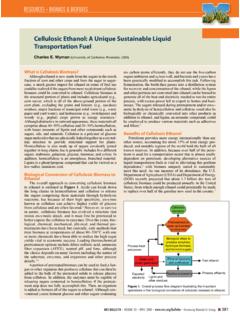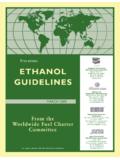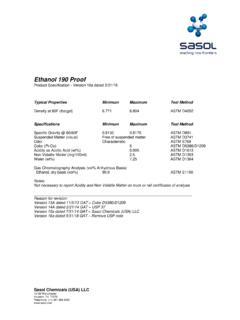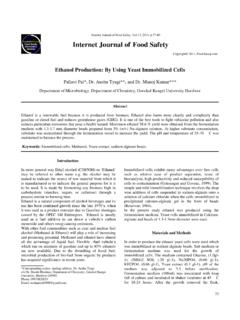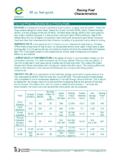Transcription of Ethanol Fuel Properties and Data Page - …
1 Ethanol fuel Properties and data Page Basic Stuff - Ethanol : Ethanol is a pure chemical substance with the formula C2H5OH (or empirically C2H6O), with a formula weight of Its gravimetric lower heating value (LHV) is 11,604 BTU/lbm, and its stoichiometric (perfectly-balanced mixture) ratio A/F is lbm of dry air per lbm of Ethanol . It is miscible with water in all proportions, with quite an affinity for moisture absorption, even from the air. It has a definite single boiling point (173 F) and a high latent heat of evaporation (396 BTU/lbm). Its specific gravity (density) is In the equivalent Reid vapor pressure test, it has a Reid vapor pressure (RVP) of 2 psi. Its autoignition temperature is about 793 F. This temperature is closely related to its extremely-high octane test ratings: motor octane (MON) , and research octane (RON) Their average would be the pump octane number (PON) that would have to be listed on the corner store s pump: for the pure material.
2 These Properties do not change: every batch of pure Ethanol is exactly like every other batch of pure Ethanol , in every way. Legally, Ethanol must be denatured to avoid being classed (and taxed) as a liquor. The most common recognized denaturant is gasoline, at 2 to 5% by volume. Basic Stuff Gasoline: Plain gasoline is a mixture of hydrocarbon substances of various formulas and widely-varying formula weights. Certain of its Properties are subject to specification limits, the composition is not. Consequently, no two batches of gasoline are ever exactly alike. Although the formula varies, it is close to with a formula weight in the neighborhood of 100 to 105. Its gravimetric LHV varies, but is usually close to 18,700 BTU/lbm. Its stoichiometric ratio also varies, but is usually close to Gasoline is immiscible with water in any proportion at all. It does not absorb moisture from the air, but atmospheric moisture condensation can occur on inside tank surfaces.
3 These lead to water bottoms : droplets, globules, or puddles of water, over which the dry gasoline floats. Not being a pure substance, gasoline has no single boiling point. Instead, the lighter fractions start boiling out at 90-100 F, with more and more evaporated as the liquid temperature increases, until the final heaviest fractions evaporate in the 300-400 F range. This behavior is called the distillation curve . Page 1 of 8 Gasoline does have a latent heat of evaporation. It varies, but is usually near 145-150 BTU/lbm, substantially easier to vaporize than Ethanol . The specific gravity can vary quite widely (from to ), but is usually near For aviation gasolines, RVP is limited by specification to psi. Automotive gasolines fall in 5 different specification volatility classes, ranging from 9 to 15 psi. All of these are considerably more volatile measures than that for Ethanol . Finished gasolines have higher autoignition temperatures and higher octane ratings.
4 It takes careful blending and additives to achieve this: raw gasoline is usually 30-45 MON. Aviation gasoline has a MON near 100 and an autoignition temperature near 495 F. Automotive gasolines have lower octane ratings and autoignition temperatures nearer 400-450 F. For example, unleaded regular (ULR) has a MON near 82 and a RON near 92, for the PON of 87 we are accustomed to seeing on the pump. Basic Stuff What Spark Ignition Engines Need: The spark-plug-equipped gasoline engine is not really limited to use only gasoline. Racers have used alcohol fuels in these same engines at Indy for decades. They are more properly called spark-ignition (SI) engines . By far the most important fuel property demanded by an SI engine is high octane rating (high autoignition temperature). Higher values of this property allow the designer to use larger, much more efficient, compression ratios. In an SI engine, as the pre-mixed fuel -air charge gets compressed by the piston moving toward the cylinderhead against closed valves, it gets very hot.
5 Hot mixture in contact with already-hot engine parts wants to explode (doing damage) instead of burning smoothly (providing power). High autoignition temperature (high octane rating) prevents the unintended sudden explosion. The second most important property is volatility . This is customarily measured by RVP, but latent heat and boiling point or initial boiling range play important roles. During cold start, there must be sufficient fuel actually vaporized during the compression for there to be a flammable mixture for the spark plug to ignite. RVP is measured at 100 F, for which Ethanol s RVP of 2 psi already looks low . If this pressure were measured at colder temperatures, the Ethanol vapor shortfall looks even worse: there is very little sensible evaporation going on below about 50 F. The higher latent heat of evaporation compounds this effect. That s why a little gasoline in the blend is beneficial to cold start, or else one must use a start canister of something flammable and volatile, like gasoline, to prime the engine for starting.
6 The third most important property is also volatility, but in the reverse sense for preventing vapor lock. Older automotive systems are much like conventional aircraft systems, in that fuel from the pump dead-heads against the metering device on the engine, waiting to be used. This is a hot environment, and the fuel gets hot while it Page 2 of 8waits to be used. The critical area is usually the low pressure inlet to the fuel pump. If the fuel begins to boil, the vapor bubbles cause the pump to lose its suction ability, and it ceases to pump fuel . This is vapor lock. Low boiling points, high RVP, and low latent heats of evaporation act to make this problem more severe. All gasolines have severe disadvantages relative to Ethanol by any of these measures. In tests, neat Ethanol has proven virtually impossible to vapor-lock. Materials compatibility is the next most important item. Ethanol is known to dissolve or damage certain materials, and can cause enhanced corrosion of metals, especially bare aluminums.
7 You have to know what these pitfalls are, in order to avoid them. Materials that cannot be used with Ethanol but can be used with gasoline are old-time lacquered cork carburetor floats, the antique zinc-based pot metal castings for fuel pumps and carburetors, and Lexan or Plexiglas if there is warm vapor contact. Materials that cannot be used with either gasoline or Ethanol are natural rubber, butyl rubber, and polystyrene plastics. Both fuels dissolve these materials. Materials that can be used with both fuels include neoprene rubber (any color), steel, aluminum, most polypropylene-type plastics, and both Lexan and Plexiglass if limited to liquid contact. Aluminum should be protected by a surface coating. The corrosivity of Ethanol to aluminum and steel is not serious as long as the Ethanol is dry, and it is far less than that of methanol, whose corrosivity gave both alcohols a bad reputation. The presence of 2+% water content greatly enhances Ethanol s corrosivity, however.
8 The presence of water in the fuel can also cause phase separation problems (see below). Thus, if Ethanol is used neat or in blend, it should be kept very dry. As a rule of thumb, anything good for gasoline is good for Ethanol is a pretty good guide, as long as Lexan or Plexiglas are not involved, and no truly antique parts are used (those are the zinc-based pot metal castings and the lacquered cork floats). Other Issues for Conversions: Metering ratio is important because an SI engine is set-up to use a particular fuel . This can be changed, however, in order to use a different fuel . In the case of a carburetor, or mechanical fuel injection, just make the metering jets larger. A flex- fuel engine must adapt its metering set-up to use whatever blend it finds in the tank. For electronic fuel injection, you can just raise the fuel rail pressure instead of changing the data in the chip. Air pre-heat and manifold hot spot are important because of cold start and cold-weather vaporization issues.
9 To adapt a gasoline set-up to use Ethanol in all weather conditions requires more heat in the intake air stream, in order to vaporize the higher-latent-heat-of-evaporation Ethanol . Without this, lean miss will occur whenever power is demanded in cool weather, especially on a cold engine. Page 3 of 8 Spark timing is important because of ignition delay issues. Ethanol actually has a slightly higher flame speed in smooth combustion than does gasoline. However, it has a much longer delay between application of the spark and a fully-formed flame (the ignition delay ). This means that the spark timing may need to be advanced. Some engines are sensitive to this, and some are not. Old-time slow-turning, small-bore, long-stroke designs are insensitive to this issue. Modern automotive engines are fast-turning, big-bore, short-stroke designs, and are very sensitive to this issue. Using Blends: The most commonly available Ethanol fuel these days is not straight Ethanol , it is a blend called E-85.
10 The E refers to Ethanol by volume in the blend, and the 85 refers to 85% Ethanol , 15% gasoline. It is usually made by mixing denatured Ethanol (an E-95 to -98 material) with ULR gasoline to reach the E-85 blend proportions. Other blends are possible: the Brazilians have been using E-22 in unmodified small gasoline engines for decades. This fuel is 22% Ethanol and 78% gasoline. In the 1970 s, an E-10 gasohol was proposed for use in the US to extend the gasoline supply during shortages. Now, in some parts of the country, ULR approximates that E-10 blend when Ethanol is used instead of MTBE as the octane-boosting additive. There are two concerns with blends: too-high-RVP vapor lock behavior and water-induced phase separation. For automotive use, vapor lock concerns vanished with modern electronic fuel injection. These feature a fuel rail with a return line. The fuel circulates continuously, so it never gets hot, and thus never vapor locks. This is still an issue for aircraft, however, as most still use a dead-head system.
